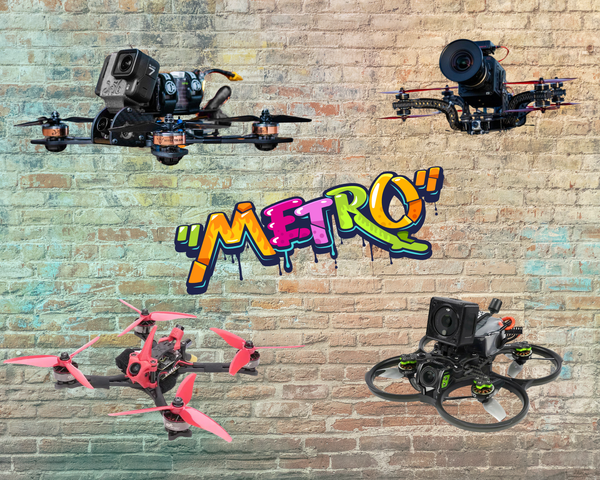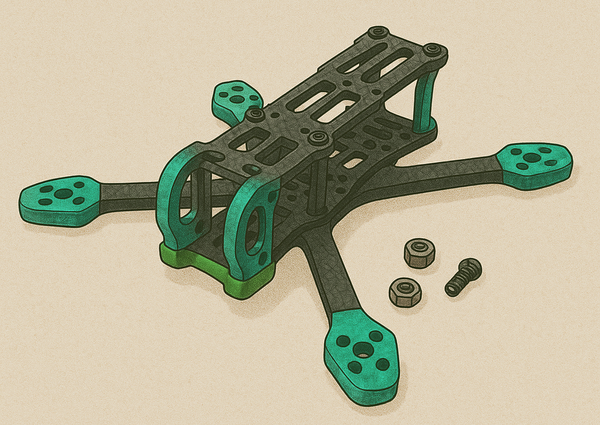5 Things That Absolutely Blew My Mind About Diving Headfirst into FPV


So, I finally took the leap. After countless hours lost in the mesmerising world of FPV drone videos – those breathtaking flights through abandoned structures, the impossibly tight dives through tiny gaps – I decided it was time to ditch the spectator seat and grab the controls myself. Let me tell you, the jump from watching those slick edits to actually strapping on the goggles is like stepping through a portal into a completely different dimension. And along this exhilarating (and sometimes slightly terrifying) journey, I’ve stumbled upon a handful of things that genuinely caught me off guard. Some were delightful surprises, others were more like unexpected turbulence, but all have shaped my early FPV experience.
Here are the top 5 things that hit me harder than a poorly-aimed power loop (again, thankfully, that’s still just a hypothetical… for now):
1. The Community: A Surprisingly Deep Well of Support and Shared Stokedness
Coming from hobbies where the community vibe could range from indifferent to outright… let’s just say competitive, the FPV community has been a breath of fresh air. I honestly expected a bit more gatekeeping, a bit of that “you gotta pay your dues” attitude. Instead, I’ve found an incredibly supportive and enthusiastic bunch of people. Whether it’s on online forums, Discord channels, or even at the local flying field, the willingness to help newcomers is genuinely heartwarming.
Got a question that feels incredibly basic? Fire away – you’ll likely get multiple helpful responses, often with detailed explanations and even links to resources. Struggling with a particular build issue that’s driving you nuts? Chances are someone else has been there, done that, and has a solution (or at least can commiserate!). This isn't just about technical help either; it's about a shared passion, a collective stoke for all things FPV. Seeing experienced pilots cheer on a beginner’s first successful hover or share tips on improving your lines is genuinely uplifting. It’s a community built on a love for flight and a desire to see others experience that same joy. This unexpected camaraderie has been a huge motivator and a fantastic resource in navigating the initial hurdles.
2. The Gear Learning Curve: It's Less a Curve, More a Cliff Face (But the View From the Top is Epic)
I consider myself reasonably tech-savvy. I can navigate software updates, troubleshoot basic computer issues, and even impress my non-techy friends with my ability to connect Bluetooth headphones on the first try. But the sheer volume and complexity of the gear involved in FPV took me by complete surprise. It’s not just a drone; it’s a meticulously assembled ecosystem of components that all need to play nicely together. Motors with their Kv ratings, Electronic Speed Controllers (ESCs) that need to be flashed, flight controllers running open-source firmware with more settings than a spaceship’s control panel, video transmitters (VTXs) and receivers (VRXs) with their own sets of protocols and frequencies, antennas that look like alien artifacts… and that’s before we even touch the radio transmitter with its endless customizable switches and the immersive FPV goggles that transport you into the drone’s perspective.
Initially, it felt like trying to learn a completely foreign language written in circuit diagrams and acronyms. There were moments of utter bewilderment, staring at wiring diagrams that looked like abstract art and feeling completely overwhelmed. But here’s the surprising silver lining: slowly, painstakingly, piece by piece, it starts to make sense. Each successful solder joint, each correctly configured setting, each maiden flight after a challenging build feels like a monumental achievement. The learning curve is undeniably steep, and there will be moments of frustration, but the deep understanding you gain of your equipment and the satisfaction of making it all work in harmony is an incredibly rewarding part of the journey. It’s like climbing a tough mountain – the ascent is challenging, but the panoramic view from the summit is absolutely worth it.
3. The Sim vs. Reality Gap: From Digital God to Gravity's Puppet (Prepare for a Reality Check)
Before even thinking about risking my precious (and newly assembled) drone in the wild blue yonder, I heeded the advice of countless experienced pilots and logged some serious hours on FPV simulators. I zipped through virtual race tracks with what felt like effortless grace, executed digital power loops with flair, and generally felt like a digital drone god. Then came my first real flight in an open field. Oh boy, was that a humbling experience.
The simulator is an invaluable tool for learning the basic stick commands and developing some muscle memory. However, it exists in a perfect, physics-lite world. Real-world flying introduces a whole new set of variables that the sim can only partially replicate. Wind – that invisible force that can send your carefully planned flight path spiraling into the unknown. Real obstacles – trees, fences, the unforgiving ground – that don’t politely vanish upon impact. And perhaps the most significant difference: the sheer, unadulterated panic that floods your system when your actual, tangible investment is hurtling towards the earth at an alarming rate. The transition from the smooth, predictable digital realm to the chaotic beauty of real-world physics is a significant one. It requires patience, a willingness to crash (and learn from it), and a healthy dose of humility. The sim gives you the fundamentals; the real sky is where you truly learn to fly.
4. The Addiction is Real (and My Wallet is Starting to Stage an Intervention)
I’ve dabbled in various hobbies over the years – some intense, some more casual. But FPV has latched onto me with a tenacity I haven’t experienced before. That feeling of putting on the goggles and being instantly transported into the cockpit of your tiny flying machine, experiencing the world from a perspective that was once reserved for birds, is utterly captivating. Suddenly, every spare moment is consumed by thoughts of FPV. I find myself watching countless hours of freestyle videos, meticulously analyzing the techniques of more experienced pilots. My evenings are spent tinkering with my drone, tweaking settings, and meticulously cleaning every speck of dust. My browser history is a never-ending scroll of drone parts, battery chargers, and FPV-related accessories. And my bank account? Let’s just say it’s starting to eye the growing collection of drones and components with a mixture of fear and resignation.
This isn’t just a passing interest; it’s a full-blown passion that ignites a sense of excitement and wonder. The constant drive to improve your skills, to push the boundaries of what you can do with your drone, and to explore new and challenging environments is incredibly compelling. It’s an addiction in the best possible way, constantly pushing you to learn, grow, and experience something truly unique. Just be forewarned: once you experience that feeling of flight, there’s a high probability you’ll be joining the ranks of FPV addicts, and your significant other might start questioning the ever-increasing number of small packages arriving at your doorstep.
5. The Unexpected Thrill of Exploration (and the Crucial Art of Ethical Adventuring)
This aspect of FPV has been a genuine revelation. While flying in designated drone parks is undoubtedly fun and a great place to hone your skills, there’s a unique and compelling allure to seeking out more unconventional flying locations. Discovering an abandoned building (a “bando” in FPV lingo) with its skeletal remains offering a challenging and visually stunning environment, finding a hidden trail winding through the trees just begging for a cinematic flight, or scouting a unique natural landscape that provides a breathtaking backdrop for your aerial acrobatics – this is where FPV truly takes on an adventurous dimension. It’s like being a miniature explorer, charting new territories from a perspective few ever get to see.
However, this thrill of exploration comes with a significant responsibility: ethical and legal flying is paramount. This means meticulously researching local drone regulations, respecting private property (no trespassing!), and adhering to the “leave no trace” principle. The goal isn’t to be reckless or нарушать закон; it’s about finding those hidden gems and experiencing them in a way that is both exhilarating and respectful. It requires a certain amount of ingenuity, a knack for spotting potential fly spots, and a commitment to being a responsible member of the FPV community. This unexpected blend of technology and exploration adds a layer of excitement and purpose to the hobby that I hadn’t fully anticipated.
So, there you have it – a more in-depth look at the five things that truly surprised me about diving headfirst into the captivating world of FPV. It’s been a journey filled with unexpected challenges, an incredible amount of support, and a level of pure, unadulterated joy that’s hard to put into words. If you’re still on the fence about joining the FPV ranks, I urge you to take the plunge. Just be prepared for a rewarding (albeit sometimes frustrating) learning process, a potentially lighter wallet, and a whole new perspective on the world around you. You might just find yourself as surprised and as hooked as I am.
If this glimpse into my FPV journey has sparked your interest, or if you're already navigating the exhilarating world of first-person view flight, I'd love for you to join the Skyzen FPV community! Subscribe to my weekly newsletter for the latest updates, insightful reads, handy tips to elevate your flying, and a chance to connect with fellow FPV enthusiasts. Let's learn, explore, and push the boundaries of what's possible in the skies together. Fly safe, and I'll see you in the next update!




